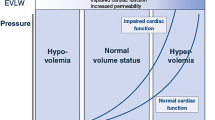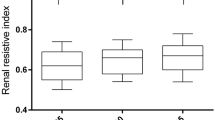Summary
The evaluation of left ventricular systolic performance in infants undergoing extracorporeal membrane oxygenation (ECMO) using traditional ejection-phase indices is hampered by significant alterations in preload and afterload. Therefore, a load-independent index, which relates heart-rate-corrected mean velocity of circumferential fiber shortening (VCFc) to afterload, measured as end-systolic wall stress (ESS), was used to assess left ventricular function in 18 term neonates undergoing ECMO. The mean age at the onset of ECMO was 75.5 h and the duration of therapy was 171±106 h. Left ventricular performance was highest before the onset of ECMO (VCFc=1.65±0.49 circ/s) and decreased toward normal during (1.38±0.33 circ/s) and following ECMO (1.29±0.16 circ/s). Initially, nine of 17 (53%) patients had enhanced performance for the degree of afterload but in only 16 of 48 (33%) studies during ECMO and none following ECMO was VCFc elevated beyond the normal range predicted for ESS. These changes in left ventricular performance may be the result of variations in exogenous, as well as endogenous, catecholamines rather than intrinsic alterations in myocardial contractility. It is concluded that the VCFc/ESS relation permits a meaningful assessment of ventricular performance in critically ill neonates undergoing ECMO.
Similar content being viewed by others
References
Bartlett RH, Roloff DW, Cornell RG, Andrews F, Dillion PW, Zwischenberger (1985) Extracorporeal circulation in neonatal respiratory failure: a prospective randomized study.Pediatrics 76:479–487
Borow KM, Green LH, Grossman W, Braunwald E (1982) Left ventricular end-systolic stress-shortening and stresslength relations in humans. Normal values and sensitivity to inotropic state.Am J Cardiol 50:1301–1308
Bucciarelli RL, Nelson RM, Egan EA, Eitzman DV, Gessner IH (1977) Transient tricuspid insufficiency of the newborn: a form of myocardiol dysfunction in stressed newborns.Pediatrics 59:330–337
Colan SD, Borow KM, Neumann A (1984) Left ventricular end-systolic wall stress-velocity of fiber shortening relation: a load-independent index of myocardial contractility.J Am Coll Cardiol 4:715–724
Colan SD, Sanders SP, Parness IA, Spevak PJ (1989) Evidence of enhanced contractility in normal infants compared to older children and adults [Abstract].J Am Coll Cardiol 13:135A
Colan SD, Trowitzsch E, Wernoysky G, Sholler GF, Sanders SP, Castaneda AR (1988) Myocardial performance after arterial switch operation for transposition of the great arteries with intact ventricular septum.Circulation 78:132–141
Douglas P, Reichek N, Plappert, Muhammad A, St John Sutton M (1983) Multiplanar analysis of left ventricular stress-shortening relationships [Abstract].Circulation 68(Suppl III):III-238
Feigenbaum H (1986)Echocardiography, 4th edn. Lea & Febiger, Philadelphia, pp 127–187
Fortuin NJ, Hood WP, Craige E (1972) Evaluation of left ventricular function by echocardiography.Circulation 46:26–35
Franklin RCG, Wyse RKH, Graham TP, Gooch VM, Deanfield JE (1990) Normal values for noninvasive estimation of left ventricular contractile state and afterload in children.Am J Cardiol 65:505–509
Gardin JM, Burn CS, Childs WJ, Henry WL (1984) Evaluation of blood flow velocity in the ascending aorta and main pulmonary artery of normal subjects by Doppler echocardiography.Am Heart J 107:310–319
Grossman W, Jones D, McLaurin LP (1975) Wall stress and patterns of hypertrophy in the human left ventricle.J Clin Invest 56:56–64
Janz RF, Ozpetek S, Ginzton LE, Laks MM (1989) Regional stress in a noncircular cylinder.Biophys J 55:173–182
Klopfenstein HS, Rudolph AM (1978) Postnatal changes in the circulation and responses to volume loading in sheep.Circ Res 42:839–845
Lagercrantz H, Bistoletti P (1973) Catecholamine release in the newborn infant at birth.Pediatr Res 11:889–893
Mahler F, Ross JR, O'Rourke RA, Covell JW (1975) Effects of changes in preload, afterload and inotropic state on ejection and isovolumic phase measures of contractility in the conscious dog.Am J Cardiol 35:626–634
Martin GR, Short BL (1988) Doppler echocardiographic evaluation of cardiac performance in infants on prolonged extracorporeal membrane oxygenation.Am J Cardiol 62:929–934
Quinones MA, Gaasch WH, Cole JS, Alexander JK (1975) Echocardiographic determination of left ventricular stressvelocity relations in man. With references to the effects of loading and contractility.Circulation 51:689–700
Redmond CR, Graves ED, Falterman KW, Ochsner JL, Arensman RM (1987) Extracorporeal membrane oxygenation for respiratory and cardiac failure in infants and children.J Thorac Cardiovasc Surg 93:199–204
Rein AJJT, Sanders SP, Colan SD, Parness IA, Epstein M (1987) Left ventricular mechanics in normal newborns.Circulation 76:1029–1036
Rowe RD, Hoffman T (1972) Transient myocardial ischemia of the newborn infant: a form of severe cardiorespiratory distress in full-term infants.J Pediatr 81:243
Slotkin TA, Seidler EJ (1988) Adrenomedullary catecholamine release in the fetus and newborn: secretory mechanisms and their role in stress and survival.J Dev Physiol 10:1–16
Trento A, Thompson A, Siewers RD, Orr RA, Kochanek P, Fuhrman B (1988) Extracorporeal membrane oxygenation in children. New trends.J Thorac Cardiovasc Surg 96:542–547
Walther FJ, Snyder JR, Gangitano ES (1988) Right and left ventricular output in newborn infants undergoing extracorporeal membrane oxygenation [Abstract].Pediatr Res 23:439A
Wisenbaugh T, Spann J, Carabello B (1983) Chronic volume overload of similar severity produces different ventricular mechanics in mitral versus aortic regurgitation [Abstract].Circulation 68(Suppl III):III-238
Author information
Authors and Affiliations
Rights and permissions
About this article
Cite this article
Berdjis, F., Takahashi, M. & Lewis, A.B. Left ventricular performance in neonates on extracorporeal membrane oxygenation. Pediatr Cardiol 13, 141–145 (1992). https://doi.org/10.1007/BF00793945
Issue Date:
DOI: https://doi.org/10.1007/BF00793945




